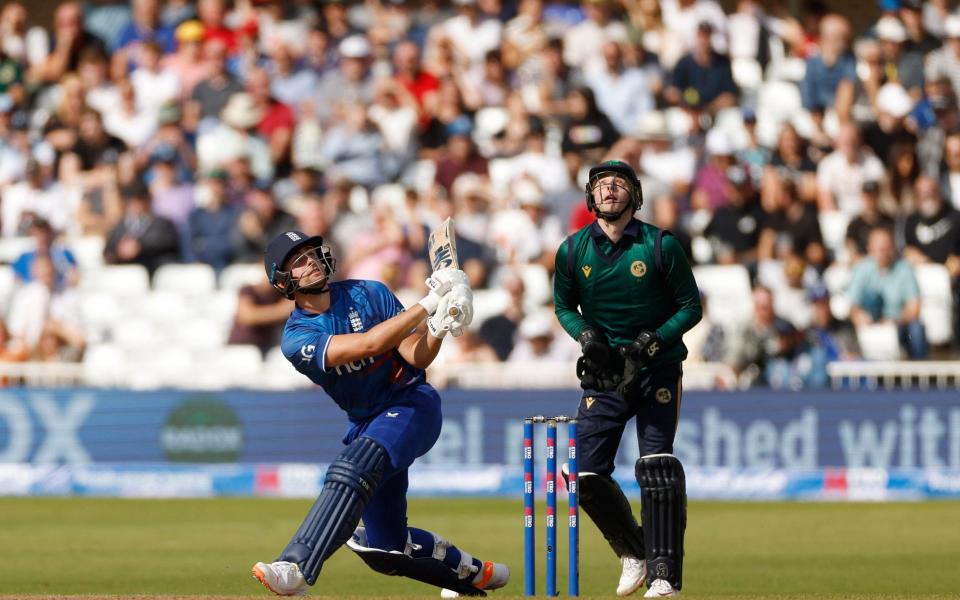England's next generation shines in win against Ireland

Just 12 days before the 2023 World Cup, England’s focus was already on the 2027 World Cup. Their XI that defeated Ireland by 48 runs at Trent Bridge did not feature any players who are in the 15 who fly to India on Wednesday, but Will Jacks, Sam Hain and Rehan Ahmed still provided a reminder of the depth of talent that now exists in the English game.
Had they played in any other era of English white-ball cricket before 2015, the three might well all be going to the World Cup. Many believe that Jacks is England’s most exciting white-ball batsman of the next generation. His rapid 94, marked by ferocious drives - including three consecutive boundaries in the second over, from Josh Little - reinforced the impression.
Two pulled sixes against back-of-a-length deliveries, from Little and Barry McCarthy, indicated the power that makes Jacks such an exciting white-ball opener. Even the manner of his dismissal - top-edging a slog-sweep off George Dockrell, avoiding any temptation to cruise to his maiden international hundred - showed the selflessness that might well make Jacks the long-term successor to Jason Roy.
Jacks is GONE! ❌
A maiden century will have to wait! 😩 pic.twitter.com/B0CDfjEZ87— Sky Sports Cricket (@SkyCricket) September 23, 2023
In his first international in his home city - though he moved to Leicestershire to accelerate his exposure to first-team cricket - Ahmed underscored England’s belief that he will in time replace Adil Rashid. While there was the occasional loose delivery, England’s way now is to focus on what players can do, rather than what they cannot. Three of Ahmed’s four wickets were with googlies; his 4-54 reaffirmed why England are so excited about his capabilities. The most pressing question for England now - and happily still a hypothetical one - is whether they would trust in a 19-year-old to replaced Rashid were he injured in the World Cup, or prefer Liam Dawson’s more dependable left-arm spin.
If Jacks and Ahmed are talents of the ilk that England long mistrusted, but have been embraced by the new white-ball culture since 2015, Hain is the reverse: a player who would be better-appreciated in previous decades than now. This explains why, despite assembling an extraordinary List A record - his average is 58 - Hain had to wait until the age of 28 to make his international debut.
In his first ever England match, Hain was confronted with a new challenge: batting at number five, a position that he has never previously occupied in the one-day game, instead making the bulk of his runs opening or at number three. Hain’s entrance to international cricket was a little jittery: he made just one off his first 11 balls and was then dropped off his 12th, when Harry Tector jumped over a cut to backward point.
From his next ball, Hain used his feet to launch Barry McCarthy over mid on for four. It was a shot that he repeated on several occasions, interspersing this power with precise placement - he ran nine twos - and a scoop for four from Little, giving notice of Hain’s recent expansion of his game. While there was no debut century - he was caught for 89 from a leading edge in England’s final over - Hain provided a promising early indication that his qualities can transfer to international level.
89 and out! ❌
An impressive innings from Sam Hain comes to an end! 👏 pic.twitter.com/cwj7m9JOEb— Sky Sports Cricket (@SkyCricket) September 23, 2023
There are more glamorous options bubbling beneath the England international side. But, even in this era of England white-ball cricket, there is still scope for later developers and batsmen whose instinctive approach is a little less gung-ho. Hain only needs to look at the man who took Roy’s place as opener: Dawid Malan, who built a formidable domestic one-day record before finally making his ODI debut aged 31. With Malan 40 by the time of the 2027 World Cup, and no guarantees about Joe Root’s involvement then either, Hain will have designs on becoming England’s anchor of choice.
England’s other three international debutants did not match Hain’s performance. Belligerent wicketkeeper-batsman Jamie Smith managed just nine before hitting Dockrell’s left-arm spin to long on; George Scrimshaw bowled four no-balls in his first over before using his pace to dismiss Paul Stirling and Lorcan Tucker; and left-arm spinner Tom Hartley was tidy but wicketless in his first ten overs. Besides Ahmed, England struggled for incision in the middle overs: Ireland slipped to 157-7 before their last three batsmen, all making career bests, lifted their total to 286 all out.
England’s new generation will brace themselves to get further chances either in Wednesday’s final ODI or on the white-ball tour to the Caribbean after the World Cup. For all their focus upon the coming weeks in India, the talent brimming beneath the full strength national squad gives England hope that the remainder of the decade could bring more white-ball trophies.

 Yahoo Sport
Yahoo Sport 




































































